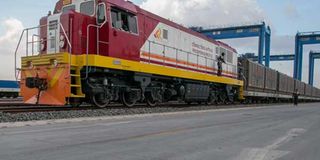Order on SGR cargo monopoly is bound to be fiercely resisted

The SGR cargo train. That is why I predict heavy resistance to migration of freight from road to rail. That is why I predict heavy resistance to migration of freight from road to rail. PHOTO | PSCU
What you need to know:
Also known as a consign or pay agreement, it aimed at tying KPA’s hands into giving SGR sufficient cargo.
This is to make the railway transport business profitable and help to service the huge loans borrowed from China Exim Bank.
For container freight stations, the order meant loss not only of business but also relevance.
Chinese loans come with tough conditions and, while signing loans for the standard gauge railway in 2013, China got the Kenya Ports Authority to sign a ‘take or pay agreement’.
Also known as a consign or pay agreement, it aimed at tying KPA’s hands into giving SGR sufficient cargo to make the railway transport business profitable and help to service the huge loans borrowed from China Exim Bank.
That agreement became part of the security package for the loans Kenya borrowed.
KPA SHAKEUP
This background explains part of the reason for last week’s major shake-up of the top management of KPA.
It was suspected that elements within KPA had been colluding with immensely influential owners of container freight stations to resist the arrangement by channelling containers to the private facilities while circumventing the SGR.
Early last month, the government directed that all containers from the port be ferried on SGR. But the directive was met with a great deal of resistance.
LOSS OF RELEVANCE
For container freight stations, the order meant loss not only of business but also relevance. Their continued existence was at stake.
Shipping lines also found themselves in danger of losing millions of shillings, especially for the service known as inter-terminal transfers, which — after the arrival of SGR — had been taken over by KPA.
Mombasa-based clearing agents also found themselves staring at a bleak future.
But their argument was not without merit.
As long as Kenya was still a free market, they said, it was unfair for the government to force importers to transport cargo on the SGR to the container terminal in Nairobi.
AXE FALLS
As the management of KPA dithered and procrastinated, Transport and Infrastructure Cabinet Secretary James Macharia swung the axe.
He, in one fell swoop, effected massive transfers of top officers of KPA, arbitrarily throwing long-serving staffers to far-flung offices in different parts of the country without regard to whether there was work for them or not.
We must now wait to see how the move to give SGR a monopoly of cargo from the Mombasa port will make the company commercially viable. And can the SGR service the huge Chinese loans?
Mark you, at stake are massive dollar loans.
CHINESE LOANS
Here are the highlights of the loans Kenya borrowed from China to build the SGR.
There was a commercial loan of $1.633 billion and a concessionary loan of $1.6 billion. These two were signed and committed in May 2014. Another $1.6 billion for the Nairobi-Naivasha section of the SGR was committed in December 2015.
And we are in the middle of negotiating $4.8 billion to take the line from Naivasha to Kisumu and on to Malaba.
What are the terms?
First, a fixed term of 15 years, inclusive of a grace period of five years. Second, interest of six months of the London Inter-Bank Offered Rate (Libor) plus 360 basis points. This comes to about four per cent of principal.
Third, a management fee of 0.75 per cent payable up-front plus a commitment fee of 0.75 per cent of the undisbursed amount. Finally, insurance from the China Export and Credit Insurance Corporation (Sinosure) at a premium of 6.93 per cent, payable in two instalments.
INTEREST RATE
Therefore, the all-inclusive cost of servicing the Chinese loans comes to an effective interest rate of 12.5 per cent.
When they tell you that Chinese loans are cheap, they are engaged in utter deception. The truth of the matter is, Chinese loans are not even cheaper than those that we borrowed from the African Development Bank (AfDB) when we were building the Thika Superhighway.
Which begs the question I have asked countless times in this column before: Where will the dollars to service these expensive loans come from?
Domestic rail-road services are non-tradeable services and can’t earn you the dollar revenues you need to service the Chinese loans.
I see ourselves ending up having to spend the dwindling dollars we earn from coffee, tea, tourism, flowers and diaspora remittances to pay the Chinese.
BORROW TO PAY
I see ourselves being forced to regularly rush to international markets to borrow the dollars to repay the principal and interest.
Which brings me to the decision by the government to force importers to use the SGR. It is not right to do it by fiat. Use soft power.
For instance, the government can introduce regulations on truck size, weight and speed limits. It can introduce regulations on driver hours and emissions and SGR-specific tariffs.
Trucking sustains a lucrative underground market for businesses dealing with many things, including contraband. And influential segments of the political elite have interests in trucking.
That is why I predict heavy resistance to migration of freight from road to rail.





